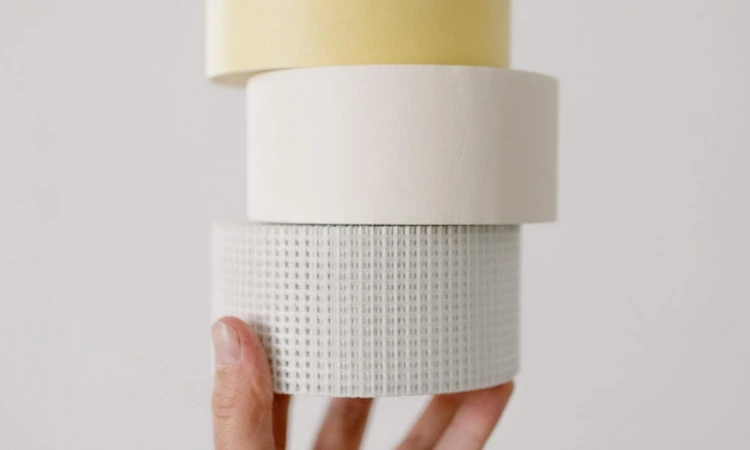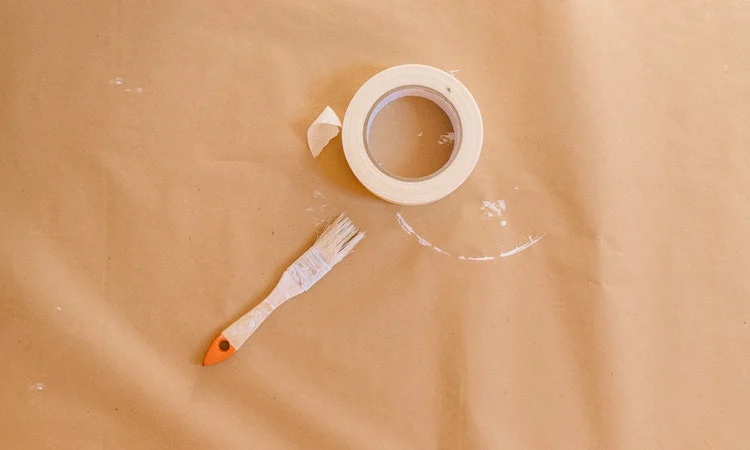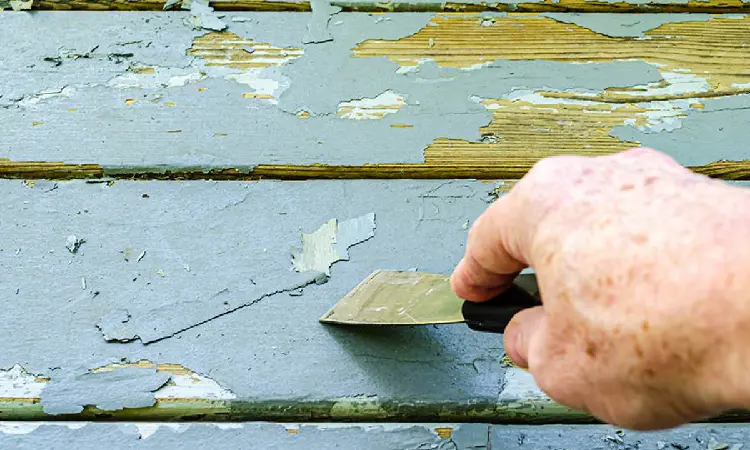Are you struggling to find a difference between masking and painter’s tape? Do you feel like the guy at the hardware store is trying to pull one over on you?
Or maybe you are wondering if you can use the two tapes interchangeably. Is there a difference between the two tapes?
Essentially, all painter’s tapes are masking tapes, but not all masking tapes are painter’s tapes.
I know that did not answer your question, but stay with me. They both have a crepe paper backing, and that is where their similarities cease.
These tapes were created for two different purposes. Masking tape is used for general projects. In contrast, painter’s tape is used for painting.
It was designed to be removed easily and stop paint from bleeding through. For this reason, it has a slightly weaker adhesive surface than masking tape.
In this article, I will discuss the differences between these two types of tape.
I will also explain why these tapes should not be used interchangeably. I hope this helps you determine which type of tape is best for your project.

Are Masking Tape and Painter’s Tape the Same?
You should not feel like you are being scammed by the guy at the hardware store. Masking tape and painter’s tape both have a crepe paper backing and can come in similar colors.
While they may look the same, there is a big difference between the two tapes.
The most obvious difference is their adhesion abilities. Masking tape is great for general taping needs around a house, classroom, or office.
At the same time, painter’s tape was designed specifically to create clean paint jobs with no paint bleeding through.
Quick Overview of Masking Tape
Masking tape is most known for its off-white color. It was designed to be sticky and not come off surfaces easily.
This tape is great for arts and crafts activities, making labels, fixing lightweight objects, etc. If you have ever used masking tape, you know it leaves surfaces sticky.
The adhesive material on the tape causes the sticky residue. This adhesive material can take a long time to be removed from surfaces.
However, it also helps the tape stick to a surface for longer. This is why this tape is used for projects where you do not want the tape to come off.
Pros of Using Masking Tape:
- Easy to tear
- It can be used inside or outside
- It comes in a variety of widths
- Versatile application
- Easy to find
Cons of using masking tape:
- Crumbles or buckles when in contact with water
- It can leave a sticky residue on surfaces when not removed within a couple of hours
- The tape may peel off paint when the tape is accidentally painted on
Can You Use Masking Tape Like Painter’s Tape?
Since painter’s tape is a form of masking tape, it is possible to use masking tape instead of painter’s tape.
However, I would not use these two interchangeably.
You may save money and time by using what you already have around the house. But at what cost to your project?
Paint can bleed through the masking tape. It is also common for the masking tape to pull paint off the walls when you remove the tape.
This is why many experts believe you should not use masking tape instead of painter’s tape.
If, for some reason, you do not have access to painter’s tape, masking tape can be used.
You should remove the tape within a couple of hours. The longer the tape sits, the tougher it will be to remove from a surface.
You also have to be careful if you are using water-based paint. Masking tape is not water-resistant.
If it comes in contact with water or water-based paints, it will crinkle and buckle up. This allows the paint to bleed through the tape and can create sloppy lines.
Quick Overview of Painter’s Tape
Painter’s tape was designed for clean and easy removal. It is less likely to leave a sticky residue on surfaces.
Professionals love painter’s tape because it allows them to create nice clean lines. The tape is also water-repellant so it does not crinkle when water-based paints are used.
Have you ever wondered why painter’s tape is bright blue or green? Well, how often do you paint a wall neon green or turquoise blue?
These colors were chosen to create a brand and because they stand out against normal paint colors.
Pros of using painter’s tape:
- Leaves no residue
- It can be left on a surface for several weeks
- Easy to tear
- It can be used inside or outside
- It comes in a variety of widths
Cons of using painter’s tape:
- Not meant to be used for months at a time
- More expensive
- It can be difficult to find
Can You Use Painter’s Tape Like Masking Tape?
Once again, I would not recommend using painter’s tape in place of masking tape. Painter’s tape is not durable and adhesive in the long term.
It also costs more money than masking tape. Why use a more expensive product for a project it is not designed for?
Differences Between Masking Tape vs. Painter’s Tape
There are countless differences between masking tape and painter’s tape. I will give you not one but twelve differences between these two types of tape.
This section should provide more insight into which type of tape you should use for your specific project.
Comparison Chart of Masking Tape and Painter’s Tape
| Masking Tape | Painter's Tape | |
|---|---|---|
| Adhesion | Weak | Strong |
| Cost | Inexpensive | More expensive |
| Paint Bleeding | Some paint bleeding | No paint bleeding |
| Availability | Easy to find | More difficult to find |
| Color Options | Wide variety of colors | 3 main color options |
| Ease of Removal | Can be difficult and messy | Easy to remove |
| Wall Safety | No super safe for walls | Very safe for use on walls |
| Durability | Very durable | Semi-durable |
Adhesion
I know I have already talked about this throughout the article. However, it is the main difference between these two types of tapes, so I feel the need to go more in-depth on this topic.
Painter’s tape has a weaker adhesive backing than masking tape.
It has a weaker adhesive backing because it is not meant to stick to a surface for longer than a couple of weeks. This tape’s purpose is to provide clean lines and keep paint from bleeding through.
It will also come off cleaner because it does not have as strong of an adhesive material.
The adhesive backing on masking tape is stronger because it is not meant to come off a surface. Masking tape should last for months or even years on a surface.
It also needs a strong adhesive backing to hold objects together. It can even be used in various ways around a house.
The strong adhesive backing on masking tape allows you to hang streamers, fix umbrellas, and more. You may not use masking tape while you are painting, but you can use it on your paint cans.
When placed around the lid of the can, this tape will prevent the can from leaking if it is accidentally knocked over.
Cost
Masking tape is significantly cheaper than painter’s tape. Many people believe there is a cost difference because one is more versatile. It would make sense that the more specialized a product is, the more money it will cost.
In this scenario, painter’s tape is the more specialized option. Therefore, it will cost more money.
You should keep this added expense in mind when choosing which type of tape to use for your project. If you are simply placing streamers, you can get away with masking tape.
However, if your project involves painting, you should consider paying extra money for painter’s tape.
Would you rather pay more for a specialized tape or use a general tape that will create a mess you will have to clean up later? Just some food for thought.
Ability to Create Clean Lines

Both types of tape can create clean lines. That said, painter’s tape is known for providing extra clean lines.
Additionally, painter’s tape can adhere better to different surfaces. It can also be left on surfaces for up to 14 days.
While masking tape can stay on a surface for a long period, it should be removed within a couple of hours when you are painting.
Remember, the longer the masking tape is on a surface, the more difficult it can be to remove without leaving behind residue.
If you have to remove and reapply tape every time you paint, it is easy to ruin your clean lines.
Plus, it will simply waste your time. This is something you should keep in mind before starting any painting project.
Paint Bleeding
It is unlikely any paint will bleed through the painter’s tape. On the other hand, the paint will most likely bleed through any kind of masking tape.
All painter’s tape is water-resistant, allowing the tape to stay strong under any kind of paint—especially water-based paints.
Masking tape will crumble and buckle when in contact with water.
This allows the paint to bleed through the tape because there are no gaps in the seal.
Availability
You can easily find masking tape in any home goods section of a store. Additionally, most grocery stores will carry masking tape.
It can be more difficult to find painter’s tape. You often travel to the home improvement store or order it online.
It may also be difficult to find different widths of painter’s tapes in the store.
Most stores will carry the basic 1- 1 ½ inch painter’s tape. If you need something bigger, you may have to look online or ask the store to order it.
Color Options
Painter’s tape is most commonly sold as the blue tape, but it is also available in green or yellow. It is more common to find off-white masking tape.
However, it is sold in various colors, from pink to orange and blue to black.
There are vibrant colors of masking tape, which are terrific for arts and crafts projects.
Ultimately, the color you choose depends on the project you are working on.
If you are painting a blue wall, you may not want to use blue painter’s tape as the tape could blend in with the paint.
The Uses of the Tape
As the name implies, painter’s tape was designed for painting projects. This tape was crafted to keep paint out.
Some manufacturers have even created a tape with absorbent polymers manufactured along the edge.
This is an added layer of protection to keep paint from seeping through the tape.
When you want straight, clean lines, you should use painter’s tape. It is the best option for when you are creating patterns and designs on a paint job.
It is also great for projects that will occur over several days, like repainting a bedroom or kitchen cabinets.
Because of these reasons, painter’s tape is the best for large painting projects. So what is masking tape used for?
Masking tape is great for small projects. It can be used on glass and canvases if you remove the tape within a couple of hours.
If you are only going to be painting small hobby projects, then masking tape can be a good alternative to painter’s tape.
There are many other things that masking tape can be used for. You can use it to support two things you are gluing together. The glue takes time to dry and properly adhere.
It can be boring holding the two items together; instead, use masking tape.
Related Read: How to Paint Glass Windows Step by Step
Ease of Removal
Both types of tape can be torn easily, but what about removing them from a surface? Painter’s tape is much easier to remove from surfaces.
Masking tape has very strong adhesion, which makes it great from a durability standpoint. But it also makes it difficult to remove.
It is common for masking tape to splinter and rips when it is being removed. Most painter’s tapes are made with more durable backings.
This allows them to be peeled off in one strip instead of pulling off multiple strips of tape.
Versatility
Masking tape is significantly more versatile than painter’s tape. It can hold objects together, create labels, display arts and crafts on walls, and so much more.
As previously mentioned, you can also use masking tape for painting, but it is not the best option.
The painter’s tape is generally only good for painting. Its adhesive substance is not strong enough to hold objects together for a prolonged period.
You can try using it for arts and crafts, but be aware the tape may not adhere for as long as you would like it to.
Wall Safety
Since painter’s tape is designed for a paint, it is also designed to go on walls and floorboards.
If removed within the timeframe specified on the label, there should not be any damage done to the walls or any other surface.
Unfortunately, masking tape can damage walls. It has a stronger adhesive substance and can pull paint off the wall. You can decrease this risk by sanding the surface before applying the masking tape.
Sanding the surface removes chips the tape could stick to and pull off.
Durability

In general, painter’s tape can stay on a surface for up to 14 days. Some tapes will state that they can last 21 days on a surface.
The main consensus among professionals is to remove the tape within 21 days. The longer the tape stays on the surface, the more difficult it can be to remove.
On the contrary, masking tape is known to last for months on a surface. Many teachers will use masking tape for decorations and labeling at the beginning of the year, and they will rarely have to replace it.
Remember that no matter what type you use, the longer it is on a surface, the more difficult it will be to remove.
The tape is slowly breaking down over time which makes it more likely to peel off in pieces and leave a nasty residue.
It is important to note that painter’s tape must not be strong and durable.
This tape is not meant to hold anything together. It is simply designed to keep paint out. That said, masking tape is designed to hold objects together for a prolonged period which is why it is more durable.
Residue
Have you ever used masking tape to label something? I bet the tape did not come off easily, and it left a sticky mess, didn’t it? While masking tape is great for long-term usage, it does leave behind a lot of sticky residues.
That residue may not be an issue when you only have to scrub it once in a blue moon when you change your labels. However, it can be difficult and time-consuming to remove that residue from a painting project.
After painting your cabinets or bedroom walls, the last thing you want to do is deal with sticky residue. Save yourself the headache and use painter’s tape when you are painting.
And instead, save the masking tape for impromptu projects around the house.
How to Remove Masking Tape Residue
The best way to remove masking tape residue is to remove the tape as soon as possible.
This is not always possible with painting projects or labeling cabinets and shelves. Thankfully, there is another way you can remove the residue.
The residue is made of glue. You can use a cloth soaked in a solvent, like a dish soap or rubbing alcohol. Simply wipe the cloth over the glue and then use a putty knife to remove the residue.
The surface can then be cleaned and dried with a microfiber cloth.
Quick Guide on How to Apply Masking or Painter’s Tape
You have decided which tape you want to use for your project. But now you want to know how to apply the tape.
Either tape can be easily applied in the same manner. Below are the steps you can use to apply the tape:
- Clean the surface either by sanding or wiping down the surface. This provides a clean area for the tape to adhere to the surface properly.
- Slowly apply the tape by lining up the edges and firmly pressing down the tape. You can break up the tape into small sections, but that is unnecessary.
- Use a putty knife or your finger to press the tape down firmly. Do not use a sharp tool, as you can damage the surface.
Verdict
All painter’s tapes are a type of masking tape, but not all masking tapes are painter’s tapes. Basically, painter’s tapes are a specialized version of masking tape.
The two types may appear similar, but they are very different.
They were both created for different purposes. Painter’s tape was created for painting. Therefore, it is durable and prevents the paint from seeping through.
Masking tape was created for general uses. It is great for everyday arts and crafts and small projects around the home or office.
While these two tapes can be used interchangeably, it is not the best idea. The painter’s tape does not have a strong enough adhesive to hold items together.
But masking tape can also let paint bleed through, and it can leave a nasty residue on surfaces.




